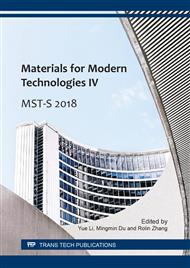[1]
Z. G. Li, Y. Li, P. Cao, et al. Surface Decontamination of Chemical Agent Surrogates Using Atmospheric Pressure Air Flow Plasma Jet.Plasma Science & Technology, 15(2013) 696-701.
DOI: 10.1088/1009-0630/15/7/17
Google Scholar
[2]
Z. Xiao, D. Xu, C. Hao, et al. High concentration xylene decomposition and diagnostic analysis by non-thermal plasma in a DBD reactor. Plasma Sci. Technol., 19(2017) 064009.
DOI: 10.1088/2058-6272/aa632c
Google Scholar
[3]
A. M. Vandenbroucke, R. Morent, N. D. Geyter, et al. Non-thermal plasmas for non-catalytic and catalytic VOC abatement. Journal of Hazardous Materials, 195(2011) 30-54.
DOI: 10.1016/j.jhazmat.2011.08.060
Google Scholar
[4]
F. Wang, H. Yi, X. Tang. Removal of NO Using a Dielectric Barrier Discharge Reactor in a Cycled Adsorption–Desorption and Decomposition System. Arab J. Sci. Eng., 42(2017)1463-1474.
DOI: 10.1007/s13369-016-2344-7
Google Scholar
[5]
J. S. Chang, K. Urashima, Y. X. Tong, et al. Simultaneous removal of NOx and SO2 from coal boiler flue gases by DC corona discharge ammonia radical shower systems: Pilot plant tests. Journal of Electrostatics, 57(2003) 313-323.
DOI: 10.1016/s0304-3886(02)00168-7
Google Scholar
[6]
Y. Liu, R. Zhang, H. Hou, et al. NO reduction using low-temperature SCR assisted by a DBD method. Plasma Sci. Technol., 20(2018) 014002.
DOI: 10.1088/2058-6272/aa9326
Google Scholar
[7]
S. Kambara, Y. Kumano, K. Yukimura. DeNOx characteristics using two staged radical injection techniques. IEEE Transactions on Dielectrics and Electrical Insulation, 16(2009) 778-784.
DOI: 10.1109/tdei.2009.5128518
Google Scholar
[8]
J. P. Sarrette, O. Eichwald, F. Marchal, et al. Electro-Hydrodynamics and Kinetic Modeling of Dry and Humid Air Flows Activated by Corona Discharges. Plasma Sci. Technol. 18(2016) 469-472.
DOI: 10.1088/1009-0630/18/5/04
Google Scholar
[9]
L. Montulli. Binary ionization technology (BITTM) the new surface and air bio/chem decontamination system. 6th Joint Service Chemical and Biological Decontamination Conference, Tucson, USA, (2005).
Google Scholar
[10]
Z. G. Li, Z. Hu, Y. Li, et al. Removal of ethyl mercaptan by nonequilibrium plasma. Chemical Industry and Engineering Progress, 28 (2009) 698-702.
Google Scholar
[11]
M. Sun, Y. Wu, J. L. Zhang, et al. Emission spectra of hydroxyl radical generated in air corona discharge. Spectroscopy and Spectral Analysis, 25(2005) 108-112.
Google Scholar
[12]
R. Li, X. Liu. Active species injection in flue gas denitrification. Chem. Eng. Sci., 55(2000) 2481-2489.
DOI: 10.1016/s0009-2509(99)00487-x
Google Scholar
[13]
J. J. Ruan, W. Li, Y. Shi, et al. Decomposition of simulated odors in municipal wastewater treatment plants by a wire-plate pulse corona reactor. Chemosphere, 59(2005) 327-333.
DOI: 10.1016/j.chemosphere.2004.10.025
Google Scholar
[14]
X. Yan, Y. Sun, T. Zhu, et al. Conversion of carbon disulfide in air by non-thermal plasma. Journal of Hazardous Materials, 261(2013) 669-674.
DOI: 10.1016/j.jhazmat.2013.07.043
Google Scholar
[15]
Z. G. Li, Z. Hu, H. L. Xi, et al. Predictive model of decontamination efficiency of gaseous pollutant by non-equilibrium plasma. Journal of Electrostatics, 68(2010) 390-393.
DOI: 10.1016/j.elstat.2010.05.010
Google Scholar
[16]
X. J. Ma, Z. C. Wu, M. H. Zhou, et al. Electrochemical scission of C-S bond in ethanethiol on a modified β–PbO2 anode in aqueous solution. Seperation and Purification Technology, 109(2013) 72-76.
DOI: 10.1016/j.seppur.2013.02.030
Google Scholar


